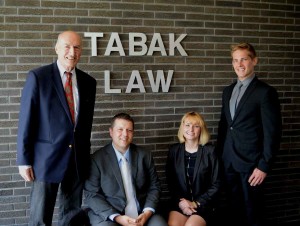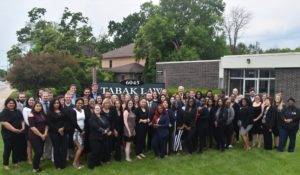WISCONSIN WORKERS CASE LAW UPDATE
WISCONSIN SUPREME COURT DECISIONS
1. Flug v. Wal-Mart Associates, Inc., 2017 Wis. 72 (2017)
2. Operton v. LIRC, 2017 WI 46, 375 Wis. 2d 1, 894 N.W. 2d 426.

Injured worker in Wisconsin
COURT OF APPEALS DECISIONS (UNPUBLISHED)
3. Amalga Composites, Inc. v. LIRC, 2016 AP 1445 (Ct. App. July 5, 2017)
4. Anthony San Felippo v. City of Wauwatosa, 2016 AP 334 (Ct. App. July 12, 2017)
5. George Payne v. Generac Power Systems, 2016 AP 236 (Ct. App. November 9, 2016)
6. Kevin Roberts v. Stevens Construction Corporation, 2015 AP 2441 (Ct. App. October 27, 2016)
7. Erie Barry v. Northstar Logistics, Inc., 2015 AP 1853 (Ct. App. February 14, 2017)
8. Larry Wittmann v. Consolidated Lumber Co., 2016 AP 1228 (Ct. App. May 13, 2017)
9. James Manowske v. Wisconsin Central, Ltd., 2016 AP 147 (Ct. App. February 22, 2017)
10. Linda S. Burt-Redding v. LIRC, 2016 AP 916 (Ct. App. July 18, 2017)
COURT OF APPEALS DECISIONS (PUBLISHED)
11. DWD v. LIRC, 2017 WI App 29
LIRC DECISIONS
12. Amy Juech v. Kettle Moraine Appliance, WCC# 2014-011391 (LIRC June 28, 2016)
13. Robert Anderson v. Village of Brooklyn, WCC# 2016-010520 (LIRC January 13, 2017)
14. Renee D. Parish v. County of Milwaukee, WCC# 2008-001804 (LIRC September 30, 2016)
15. Kenyatta N. Barber v. Art Institute of Wisconsin, WCC# 2014-013533 (LIRC November 17, 2016)
16. Carl Janssen v. Monode Steel Stamp, Inc., WCC# 2013-007952 (LIRC June 07, 2017)
17. Judith A. Chovanec v Wal-Mart, Inc., WCC# 2014-030273 (LIRC February 26, 2016)
18. Linda Schue-Nilles v. Marketplace Foods, Inc., WCC# 2014-000894 (LIRC July 20, 2016)
19. Barry Pipkin v. Nick H. Hull, WCC# 2015-010177 (LIRC October 31, 2016)
20. Michael Bukovic v. CPF, Inc., WCC# 2014-029138 (LIRC December 12, 2016)
21. Mark J. Musial v. City of Green Bay, WCC# 2014-004700 (LIRC June 30, 2017)
22. Ochieno H. Amos v. Mentor Management Inc., WCC# 2012-028655 (LIRC January 13, 2017)
23. Stanley Jacquet, Jr. v. Allstar Exteriors and the LIEF, WCC# 2016-005631 (LIRC June 7, 2017)
24. James Rogers v Meyers Electric, Inc., WCC# 2015-010853 and 2013-025125 (LIRC May 12, 2017)
25. Linda M. Bledsoe v Mequon Care Center, et al, WCC# 2012-006691 (LIRC March 31, 2016)
26. Scott Breitzman v. Airpro Fan & Blower Company, WCC# 2012-019990 (LIRC June 7, 2017)
27. Darryl A. Welch v. Griffiths Corp., WCC# 2013-020601 (LIRC June 7, 2017)
28. Kittie K. Crossen v. Harley-Davidson Motor Co. Group, LLC, WCC# 2011-011182 (LIRC December 12, 2016)
29. Ann L. Weinzatl v. Harley-Davidson Motor Co., LLC, WCC# 2014-008047 (LIRC December 28, 2016) –
30. Adam P. Goodman v. Bartlein Barrels Inc., WCC# 2015-009026 (LIRC June 30, 2017)
31. Keston K. Jamerson v. Cross Country Cable Corp., WCC# 2015-001760 (LIRC June 30, 2017)
32. Alvin A. Villareal v. SPX Corp., WCC# 2014-031662 (LIRC June 30, 2017)
33. Jacob B. Wein v. AD Roofing LLC, WCC# 2011-024653 (LIRC June 30, 2017)
34. Janice P. Bruton v. Service Master by Berger, WCC# 2011-003574 (LIRC June 30, 2017)
35. Randall Adamowicz v. Old Carco LLC, WCC# 2005-018339 (LIRC June 30, 2017)
36. Janet Mueller v. Ashley Furniture, WCC# 2013-027631 (LIRC July 13, 2017)
37. Robin Eisenhauer v. Dollar Tree Stores, WCC# 2014-009733 (LIRC July 13, 2017)
38. Elizabeth S. Vera v. Southwest Airlines, WCC# 2015-020808 (LIRC July 28, 2017)
39. Lonney Goman v. Tutor-Perini Corp, WCC #2015-011682 (LIRC August 18, 2017)
LET’S GET STARTED WITH TABAK LAW
1. Flug v. Wal-Mart Associates, Inc., 2017 Wis. 72 (2017)
In 2017 the Wisconsin Supreme Court finally decided a case construing the new §102.42(1m), Stats. In this case, Flug had two medical conditions – a soft tissue strain and a degenerative disc disease of her spine. Flug underwent surgery under the belief that it was necessary to treat her work-related injury. The surgery left Flug with a permanent disability, and she claimed PPD because she believed, in good faith, that she was having surgery to treat her work-related condition. The ALJ found that although Ms. Flug suffered an injury at work, there was legitimate doubt as to the compensability of the claim beyond what was already conceded and paid by the employer and dismissed the claim. On appeal, LIRC affirmed the ALJ’s decision stating specifically that Flug was not entitled to PPD because the ALJ had expressed legitimate doubt as to whether Flug “suffered any work injury.” Flug appealed to the Circuit Court where LIRC admitted its mistake but argued that the work-related injury had reached an end of healing and that the surgery was not for the work injury. The Circuit Court assumed the existence of the work injury but concluded LIRC had a sufficient factual basis to deny the claim for further benefits. Flug appealed. The Court of Appeals decision (discussed last year), focused on whether the disability creating treatment must be undertaken to treat a compensable injury to qualify the employee for benefits. The Court interpreted §102.42(1 m), Stats. to mean there was no requirement for a relationship between the injury and the treatment to award benefits. It concluded that all Flug needed was a good faith belief that the treatment was related to the work injury to receive PPD. LIRC appealed to the Supreme Court and asked for a limited review to interpret the following question. “Does Wisconsin Statutes Section 102.42(1m) make an employer liable for disability resulting from an invasive treatment, when the claimant has not established that the treatment in fact treated a compensable work injury?” The majority of the court reversed the lower court’s finding and affirmed LIRC’s order dismissing the claim for benefits. And that is the simple part. There are a total of 75 pages of majority opinion, dissent, and attachments. In an extremely painful examination of the minutia of statutory language, the Supreme Court finally reached the conclusion that the intent behind this statutory section was to allow benefits when the treatment was for a compensable injury regardless of the employee’s belief. As the dissent points out, Flug’s good faith belief that the medical treatment was for a work-related injury was made irrelevant by the majority decision. Interestingly, if you read the legislative history behind §102.42(1m) and Footnote 180 in the DWD’s statutory book, the intent was to make the employer liable for an allegedly unnecessary invasive form of treatment for a work-related condition. For whatever reason, the Court of Appeals found it meant something different. The Supreme Court reeled them back in, but it is one of the more confusing and tortured analyses to come out of the Supreme Court on a worker’s compensation case in many years.
2. Operton v. LIRC, 2017 WI 46, 375 Wis. 2d 1,894 N.W. 2d 426.
MISCONDUCT AND SUBSTANTIAL FAULT
The Wisconsin Supreme Court unanimously held that an employee’s eight accidental or careless cash handling errors over the course of 80,000 transactions were inadvertent errors under Wis. Stat. §108.04(5g)(a)2 and not “substantial fault.” The employee worked for Walgreens for 21 months, mostly as a cashier. She handled 80,000cash transactions and committed eight errors at the cost of $555.36. Walgreens warned her several times about the errors she committed, ultimately terminating her employment after the eighth mistake. Walgreens then disputed the employee’s claim for unemployment insurance, alleging misconduct deprived her of unemployment insurance. After a hearing before an ALJ, the unemployment insurance claim was denied, not for misconduct, but for substantial fault. The ALJ held that the employee did not intend to disregard the employer’s interests and was not so careless as to manifest culpability or wrongful intent. LIRC affirmed the ALJ’s decision without modification. LIRC’s decision was affirmed by the circuit court but reversed by the appeals court. The Supreme Court affirmed the appeals court. The Supreme Court reasoned that Wis. Stat. §108.04(5g)(a)2 provides that substantial fault does not include “one or more inadvertent errors made by the employee.” The court defined “inadvertent” as accidental oversight, carelessness, passive negligence and unintentional conduct. The court held that the employee’s mistakes were inadvertent because they occurred over a period of 21 months and 80,000 transactions. The employee worked for several months at a time without making a mistake. Finally, each of her mistakes was different in kind from the other. The court suggested that the employer’s warnings may be relevant to whether an error is inadvertent, but not dispositive. The court also held that there might be a number of inadvertent errors that become intentional. Two justices concurred in the result, but argued that the Statute did not refer to warnings and therefore they were irrelevant to an inadvertent error determination. The concurring justices also argued that the Statute allows for “one or more” inadvertent errors, suggesting that the number of inadvertent errors is irrelevant and that instead the quality of each error must be assessed.

Workers Comp Attorney Alex Eichhorn
COURT OF APPEALS DECISIONS
3. Amalga Composites, Inc. v. LIRC, 2016 AP 1445 (Ct. App. July 5, 2017)
UNDOCUMENTED WORKERS AND §102.35(3)
Gomez-Sandoval claimed unreasonable refusal to rehire after she was released to return to work without restrictions for a work injury in December of 2012. On July 9,2013 she filed an application and on July 17, 2013 Amalga contacted her offering work.She returned on July 29, 2013. A month later Amalga told her there was an issue withher Social Security number. Amalga gave her 30 days to address the issue. Gomez Sandoval did not correct the issue and Amalga terminated the employment. The ALJ found that Amalga had failed to establish good cause for not rehiring Gomez-Sandoval. Amalga petitioned for review to LIRC arguing the Immigration Act barred any back wages for undocumented workers. LIRC affirmed the ALJ’s decision and found the Immigration Act did not bar the applicant’s claim for benefits under §102.35(3). Amalga then appealed to the trial court who noted that neither the ALJ nor LIRC had made a finding of whether the applicant was an undocumented worker. However, the trial court affirmed LIRC’s decision that the Immigration Act did not bar the applicant’s claim for back wages. Amalga appealed and the Court of Appeals found that it did matter whether Gomez-Sandoval was an undocumented worker, and the absence of a finding on that fact prohibited further consideration of any of the arguments raised on appeal. The Court determined they could not proceed until LIRC made a factual finding on whether Amalga met its burden of proof on its claim that Gomez-Sandoval was an undocumented worker. The matter was remanded to LIRC to make this factual finding, but the remand did not require LIRC to have further hearings.
4. Anthony San Felippo v. City of Wauwatosa, 2016 AP 334 (Ct. App. July 12, 2017)
DUTY DISABILITY
San Felippo was a firefighter who claimed an occupational lung condition caused by a specific exposure to a coal fire occurring on November 8, 2012 at a power plant. He made a claim for duty disability benefits. Wisconsin Statutes §891.45 contains a presumption that a firefighter without a history of prior respiratory impairment or disease who claims a respiratory related disability should be presumed to have developed the condition as a result of employment as a firefighter. Based on that presumption, the employee was awarded benefits by the ALJ. LIRC reversed after a review of the medical evidence finding San Felippo failed to demonstrate the lung condition was caused by exposure at the coal fire. LIRC found the medical opinion offered by the respondent was sufficient to rebut the presumption of a work related lung condition. On appeal, San Felippo raised multiple arguments regarding the application of the presumption. He also argued that LIRC applied the presumption incorrectly. An amicus brief was filed on behalf of San Felippo raising the argument that §891.45(2)(3) contains a presumption in favor of firefighters who develop impairments as the result of exposure to infectious diseases. The Court rejected the argument claiming that it had not been raised before LIRC and affirmed LIRC’s finding that the medical evidence submitted by the employer was enough to rebut the presumption in the Statute.
5. George Payne v. Generac Power Systems, 2016 AP 236 (Ct. App. November 9, 2016)
STANDARD OF REVIEW
Payne worked as a welder/fabricator at Generac carrying and welding heavy parts. Beginning in 2003 Payne began complaining of back difficulties and sought chiropractic treatment as well as periodic doctor visits, physical therapy and classes at the YMCA. Sometimes he would tell folks his back hurt because of the heavy work he did, and sometimes he would tell folks his back hurt because of poor footwear, slipping on ice, falling down stairs and having “busy weekends”. He was eventually diagnosed with severe degenerative changes at the L4-L5 level with multiple level disc degeneration and “congenital shortening of the pedicles”. According to the Court of Appeals, this condition predisposes a person to spinal stenosis. The IME with Dr. Krug was a bit of a mess. Initially, Dr. Krug did not have the chiropractic treatment records. The carrier got the records to Dr. Krug and obtained an addendum report stating the condition was not work-related. The ALJ awarded benefits. On appeal, LIRC took them away. LIRC stated there was legitimate doubt that Payne had sustained any injury arising out of his employment with Generac. Payne appealed, and the Court of Appeals refused to reverse LIRC noting LIRC was the ultimate finder of fact and their findings were conclusive on appeal as long as they were supported by credible and substantial evidence. They gave great deference to LIRC’s decision. Payne argued he had to use a back belt as part of his job. There were pictures of the back belt available for review by LIRC. The original back belt was available at the workers compensation hearing, but not to LIRC. Because LIRC didn’t reference reviewing pictures of the back belt in their decision, Payne argued for reversal as LIRC failed to consider a key factual issue. The Court of Appeals pointed out Payne failed to provide any evidence supporting his theory that the wear and tear on the belt resulted from repetitive ending and twisting, or any evidence as to the age and condition of the belt when he acquired it. They noted that the case did not turn on the presence or absence of the back belt photos, but on the expert evidence regarding Payne’s medical condition. Of interest was Payne’s argument that LIRC erred when relying on Llewellyn in denying benefits. Payne argued that Llewellyn does not provide the proper standard of review because Llewellyn didn’t deal with the issue of occupational disease. The Court of Appeals rejected that argument stating Llewellyn applied to cases involving preexisting conditions.
6. Kevin Roberts v. Stevens Construction Corporation, 2015 AP 2441 (Ct. App. October 27, 2016)
WRONGFUL REFUSAL TO REHIRE
Roberts worked as a construction manager on a project in Michigan. After a work injury he was unable to continue working on the Michigan project. About a month after the injury Roberts was released to return to work without restrictions. On the same day that Roberts showed up for work he also received a letter from the employer indicating is position was terminated. Roberts sued for wrongful refusal to rehire.
The ALJ dismissed the claim; LIRC affirmed the dismissal; and the Circuit Court affirmed LIRC. The Court of Appeals focused on whether the employer showed a reasonable cause for its refusal to rehire Roberts. They noted LIRC found the employer demonstrated reasonable cause, lack of work, because the Michigan project that Roberts had been hired to do was coming to an end, and other workers had already been laid off. Roberts argued that other employees on the Michigan project had been moved to other positions or were allowed to utilize their PTO to stay employed. But Roberts never demonstrated that he had any PTO remaining.The Court of Appeals noted the employer does not have to modify its policies to ensure a previously injured employee is rehired. The employer had established reasonable cause for not rehiring Roberts because he had not been a “model employee” and because of the business’ slow down with the closing of the Michigan project. The employer testified there were no other positions they could move Roberts to within the company. The Court allowed for a rather narrow interpretation of what suitable employment means, and this decision may narrow the field for jobs that the employer must consider offering the injured worker.
7. Erie Barry v. Northstar Logistics, Inc., 2015 AP 1853 (Ct. App. February 14, 2017)
WRONGFUL REFUSAL TO REHIRE
Barry worked as a truck driver for the employer driving a route from Milwaukee to Appleton. She sustained an injury and underwent surgery. In October of 2013 Barry spoke with the company president about her anticipated return to work. The company president told Barry that Northstar was going through restructuring and it would no longer offer the route from Milwaukee to Appleton to Barry. The company president offered Barry a delivery route from Appleton to De Pere and Marinette. On December 2, 2013 Barry returned to work and met with her supervisor. At the meeting the supervisor again offered the Appleton delivery route to Barry. Barry rejected the offer and was terminated. The factual dispute in the case centers on whether Barry was actually offered do the Appleton route. Barry said she wasn’t and the employer said she was. At the hearing only Barry and the company president testified. Her supervisor did not. The ALJ dismissed the claim finding Barry had been offered the job and had rejected it. LIRC affirmed, and the Circuit Court affirmed LIRC. The Court of Appeals affirmed. What makes the Court of Appeals’ decision interesting is their ruling on Barry’s argument that LIRC relied on uncorroborated hearsay evidence to reach the conclusion that Barry was offered the Appleton route. Barry argued that because the supervisor wasn’t there to testify about the conversation on December 2, 2013, the information about that meeting offered by the company president was nothing more than hearsay and could not be relied upon to deny her claim. The Court of Appeals sidestepped the issue of whether uncorroborated hearsay could be sufficient evidence at an administrative hearing. Instead, it found the original offer made by the company president to Barry and Barry’s rejection of that offer was sufficient evidence. The end result is that Barry’s argument may have won the case but for the fact that the company president had offered the job before the meeting with her supervisor.
8. Larry Wittmann v. Consolidated Lumber Co., 2016 AP 1228 (Ct. App. May 13, 2017)

Wisconsin Work Comp Lawyers who care!
HEALING PERIOD
Wittmann injured his right ankle working as a sales person for Consolidated
Lumber. An x-ray of the ankle revealed a spiral fracture of the right fibula. After the injury Wittmann continued to work full-time and lost no wages. He was never given any permanent restrictions. By January of 2008 Wittmann was allowed to resume full weightbearing on his injured ankle without using a boot or crutches. By the end of February of 2008, x-rays demonstrated he had a healed fracture. Wittmann was fired by his employer on November 18, 2008. Three months later he went in for a MRI of his ankle which revealed possible cartilage and ligament defects. In December of 2010 Wittmann was offered surgery on his ankle which he declined. In January of 2012 Wittmann saw Dr. Lockheart who wrote an opinion stating Wittmann’s ankle had not fully healed until January of 2012. Wittmann then claimed temporary total disability benefits running from his termination date until the date of the report from Dr. Lockheart. The ALJ denied the applicant’s claim. LIRC affirmed. LIRC relied upon the medical opinions of the independent medical evaluator who stated the end of healing occurred in February of 2008 when the applicant’s original doctor released him to full duty. Wittmann appealed to the Circuit Court who affirmed LIRC. At the Court of Appeals, Wittmann argued he was still in a healing period because he was still actively treating between 2008 and 2012. Wittmann argued that Dr. Lockheart’s report in 2012 was the end of the treatment he went through between 2008 and 2012. The Court of Appeals noted the mere fact Wittmann continued to seek treatment after he was terminated from employment did not make LIRC’s factual determination that the end of healing occurred in February of 2008 unreasonable. The Court found the release to full duty and the “notable delays” between Wittmann’s doctor visits supported LIRC’s conclusion that he was not in a healing period, because his injury had become “stationary” well prior to his termination. The interesting part of this case is the question that is often asked of defense counsel by clients seeking guidance on when the end of healing occurs. The case gives credence to the argument that a release to full duty without restrictions even if the employee is still seeking medical treatment is an end of healing for purposes of a workers compensation claim.
9. James Manowske v. Wisconsin Central, Ltd., 2016 AP 147 (Ct. App. February 22, 2017)
FELA
Manowske worked for the railroad and was walking in the employer’s parking lot when he slipped and fell on an icy manhole cover. Because Manowske worked for the railroad, the case was handled under the Rules of the Federal Employer’s Liability Act. That means the case was in Circuit Court and not an administrative hearing. The Circuit Court grated summary judgement to the railroad determining that as a matter of law Manowske’s injuries were not “foreseeable”. As noted by the Court of Appeals, FELA provides coverage for any injury suffered by an employee working for the railroad “resulting in whole or in part from the negligence of any of the officers, agents or employees of such carrier.” Manowske argued any reasonable employer in the railroad’s position could foresee the potential for harm to an employee in Wisconsin winters. The railroad argued the summary judgement was appropriate because there was no evidence
the railroad was aware of the risk to Manowske. In reversing the summary judgement for the railroad, the Court of Appeals noted that FELA’s standard was far different than the standard in a regular negligence case. They noted there was a material issue of fact on whether the harm to Manowske was foreseeable by the railroad. As noted by the Court, normal Wisconsin winter conditions provide sufficient notice to any employer of a potential injury caused by a slip and fall. This case is included simply to point out there are other workers compensation laws at work in Wisconsin that have nothing to do with Ch. 102. Be aware that these potential claims provide another avenue of litigation.
10. Linda S. Burt-Redding v. LIRC, 2016 AP 916 (Ct. App. July 18, 2017)
MENTAL INJURY
Burt-Redding worked as a patrol officer for the Grand Chute Police Department. In 2002 while in the course of her employment, she shot an individual who was a member of a street gang. After the shooting, Burt-Redding received threats made directly against her, threats made directly against her son, and reports of threats received from the Police Chief who warned Burt-Redding that the family of the gang member she shot was threatening her life. Burt-Redding claimed these threats caused anxiety attacks, chronic depression and PTSD. She made a claim for WC benefits.
The ALJ found the threats alone or in combination did not amount to extraordinary stress and denied benefits. LIRC affirmed the denial citing the Bretl decision. The Circuit Court affirmed LIRC’s denial of benefits and Burt-Redding appealed to the Court of Appeals. The Court of Appeals cited the extraordinary stress test and specifically found that in order to be compensable, the mental injury for Burt-Redding must have resulted from a situation of greater dimensions than the day-to-day emotional strain and tension that similarly situated employees experience in the course of their employment. The Court of Appeals denied benefits based on testimony from the Police Chief and a police science instructor who testified it was not unusual for police officers to receive threats. They found the threats, even though there were threats made against Burt-Redding’s son, were not unusual for police officers in similar situations.
11. DWD v. LIRC, 2017 WI App 29 (Ct. App. 2017)
MISCONDUCT
The dispute turned on the meaning of a 2014 amendment to the UI Statute that defines when an employee’s violation of an employer’s written attendance policy constitutes “misconduct” under Wis. Stat. §108.04(5)(e). Wis. Stat. §108.04(5)(e) defines “misconduct” as “[a]bsenteeism by an employee on more than 2 occasions within the 120-day period before the date of the employee’s termination, unless otherwise specified by his or her employer in an employment manual of which the employee has acknowledged receipt with his or her signature … if the employee does not provide to his or her employer both notice and one or more valid reasons for the absenteeism.” In this case, an employer terminated an employee’s employment because she missed one day of work without phoning to notify her employer at least two hours in advance of her shift. At hire, she signed a form acknowledging that her employer’s attendance policy mandated employment termination for such a violation. The employer denied the employee’s UI claim, asserting misconduct for violating the attendance policy. A DWD UI ALJ upheld the UI denial, but LIRC reversed, ruling that the Statute required employers to allow at least two work absences in 120 days before terminating employment. In a 2-1 divided decision, the appeals court affirmed LIRC’s interpretation of the Statute. It held that LIRC’s interpretation was the most reasonable alternative because a one-absence rule was too draconian. The court held that Wis. Stat. §102.08(5)(e) does not allow attendance policies with only one missed day of work to qualify as “misconduct” under that specific statutory provision. In this case, because the employee was absent due to illness she was not found to have engaged in general misconduct. The court suggested that if she had spent the day drinking at a bar, a general misconduct finding would have been warranted. The dissenting justice argued that the Statute’s language is plain that any employer promulgated attendance policy supplants the Statute. The dissent justice argued that Wis. Stat. §102.08(5)(e) is a “default” provision that sets the limit at no more than two absences in a 120-day period, only where the employer has no contrary policy. The Wisconsin Supreme Court agreed to review the appeal court’s decision. On its own motion, the court also added this issue: “Does the practice of deferring to agency interpretations of statutes comport with Article VI I, Section 2 of the Wisconsin Constitution, which vests the judicial power in the unified court system?” At least two concurring opinions in the Operton case included comments by justices questioning whether deferring to legal interpretations by LIRC, or any other administrative agency, is constitutional.
LIRC DECISIONS
12. Amy Juech v. Kettle Moraine Appliance, WCC# 2014-011391 (LIRC June 28, 2016)
COVERAGE
Kettle Moraine had workers compensation insurance coverage through Sheboygan Falls Mutual that ended January 7, 2013. The agent for the employer attempted to place coverage with Harleysville Insurance through an online application on January 8, 2013. Harleysville claims the coverage was never bound and that the agent and employer should have known that. Juech injured her leg during what would have been the Harleysville coverage period and Kettle Moraine submitted the claim to Harleysville. Harleysville claimed there was no coverage and filed a reverse application for hearing seeking a finding from an administrative law judge that there was no coverage. The director of the Bureau of Legal Services sent a letter to the attorney for
Harleysville stating the Department had no record of coverage for the employer between January 8, 2013 and December 5, 2013. Apparently unsatisfied with this, Harleysville pushed for a hearing, but the application was dismissed (although Harleysville claimed they never received the Notice of Dismissal). When Harleysville received the Dismissal Order, they filed a Petition for Review with LIRC. LIRC dismissed stating they could not review the matter as there was no decision that awarded or denied workers compensation benefits. The Commission did note the employee had a right to bring a workers compensation claim and at that hearing the ALJ could determine whether there was coverage through Harleysville.
13. Robert Anderson v. Village of Brooklyn, WCC# 2016-010520 (LIRC January 13, 2017)
DEFAMATION
Anderson filed an application claiming defamation. LIRC’s decision does not include details of how Anderson was defamed. LIRC states Anderson believed he did not need medical support for his claim of defamation. LIRC found that in the absence of medical evidence of an injury, Anderson could not prove a claim under Chapter 102. Anderson asked LIRC to expand the definition of injury to include “harm to reputation.”LIRC noted it had to apply the law as written, and there was no coverage for “harm to reputation” under the workers compensation Statutes.
14. Renee D. Parish v. County of Milwaukee, WCC# 2008-001804 (LIRC September 30, 2016)
VOCATIONAL REHABILITATION
Parish claimed multiple injury dates while working for the County. She asserted entitlement to vocational rehab retraining under §102.61, Stats. The ALJ found that Parish became eligible for retraining benefits in 2009 when she resigned her employment from the County. However, she failed to pursue a claim for vocational retraining until March of 2014. Siting the Statute stating the employee must pursue vocational retraining benefits within 60 days from the date the employee was sufficiently recovered from injury to permit so doing, LIRC dismissed the application finding that Parish sat on her retraining options for too long. LIRC did note that the 60-day rule was not an absolute bar, but five years was too long to wait.
15. Kenyatta N. Barber v. Art Institute of Wisconsin, WCC# 2014-013533 (LIRCNovember 17, 2016)

Wisconsin social security attorneys
MENTAL MENTAL INJURY
Barber worked for the Art Institute. She listed a number of events occurring during her term as “Student Affairs Coordinator” that caused her to develop PTSD. Although there doesn’t appear to be any dispute regarding the factual issues in the case (including threats of violence in the classroom, potentially suicidal students, or confrontation with felons), LIRC found Barber could not demonstrate she was experiencing unusual or “unexpected” stress in the workplace. The school’s Dean testified that not only had she dealt with these same problems before she hired Barber, she advised Barber that she could reasonably expect to deal with these issues on a daily basis before Barber took the job. As noted by LIRC, “Students engaging in theft, becoming belligerent or emotionally distraught are not out of the ordinary. Nor, unfortunately can it be said to be unusual for students to have to deal with unwanted attention to the point of obtaining restraining orders. Dealing with such matters may have caused [Barber’s] stress, particularly since she admittedly led a sheltered life growing up, but those situations are ones that someone in [Barber’s] position could be expected to face. [Barber] did not meet her burden of establishing she was subjected to greater stress than those who are similarly situated.”
16. Carl Janssen v. Monode Steel Stamp, Inc., WCC# 2013-007952 (LIRC June 07, 2017)
LOEC
Janssen claimed a work-related injury to his back. A hearing was held and the ALJ awarded benefits. LIRC found 2% PPD caused by a work-related injury and reserved jurisdiction on loss of earning capacity. By agreement, the parties stipulated to each other’s loss of earning capacity assessments and asked the ALJ to issue a decision on loss of earning capacity. The ALJ awarded loss of earning capacity benefits and the employer appealed. LIRC awarded loss of earning capacity benefits at a rate lower than what was awarded by the ALJ. At LIRC the employer argued the displaced worker theory, and that Janssen was offered the opportunity to work in Ohio when the employer shut down its plant in Janesville. LIRC noted that the vocational expert relied upon by the employer referred to the “dislocated” worker theory. LIRC found it was unlikely the applicant, if he was in fact “dislocated”, could restore the lost wages without picking up and moving to Ohio. LIRC stated Janssen was not required to move to Ohio and take the job offered to him.
17. Judith A. Chovanec v Wal-Mart, Inc., WCC# 2014-030273 (LIRC February 26, 2016)
COURSE OF EMPLOYMENT
Chovanec punched out from her work shift and went to the back of the Wal-Mart store to remove tables that she planned to use for her private yard sale. Nine minutes after she clocked out, she claimed an injury sustained while moving the tables. Chovanec had permission from the employer to use the tables for her yard sale. The ALJ found Chovanec was not in the course of her employment at the time of the injury. LIRC affirmed siting Ide v. LIRC. Chovanec argued she was still in the course of her employment because the employer loaned the tables to her to improve “employee morale” and that the employer received a benefit from loaning the tables which put her in the course of her employment. LIRC didn’t buy the argument, and found she was engaged in a personal deviation from employment at the time of her injury and was not entitled to workers compensation benefits.
18. Linda Schue-Nilles v. Marketplace Foods, Inc., WCC# 2014-000894 (LIRC July 20,2016)

Work Comp Claimant
The employee was injured when she twisted her knee while putting on her snow boots as.she prepared to leave work on a cold winter’s day. At the time of her injury, she had finished her shift, but had not yet punched out. She tore her ACL and her meniscus and required surgical repair. The ALJ found the injury compensable and awarded benefits. LIRC affirmed. The employer argued that Schue-Nilles was not in the scope or course of her employment at the time of her injury and that the injury did not arise of employment. The employer’s assistant manager stated he did not prohibit workers from changing footwear on the employer’s premises, and LIRC found Schue-Nilles was covered by the “comings and goings rule” under § 102.03(1 )(C)(2). There was no evidence she was actually outside the employer’s premises on a direct route to her car when the injury happened.
LIRC stated that even if she had punched out before putting on her snow boots in preparation for leaving, she would still be performing services growing out of and incidental to her employment and covered by the comings and goings rule while still inside the store. Schue-Nilles did self-refer to the Mayo Clinic. The Commission did not make the employer pay for the out-of-state medical treatment as there was no evidence the practitioners were licensed to practice in Wisconsin. The employer appealed to Circuit Court and the Circuit Court reversed LIRC finding the applicant’s injury did not incur in the course of her employment. LIRC appealed to the Court of Appeals.
19. Barry Pipkin v. Nick H. Hull, WCC# 2015-010177 (LIRC October 31, 2016)
Pipkin was hauling a load to Phoenix, AZ. On his way to drop off the load outside of Phoenix, Pipkin claimed he was cut off by a driver in a black SUV. Pipkin claimed the
black SUV slowed down and sped up intentionally to prevent Pipkin from doing his job. When Pipkin exited the highway, he claims the SUV followed him and the driver got out
and waited for Mr. Pipkin. Pipkin testified that he exited his vehicle and asked the driver what he was doing, then turned to get back into his truck. He claims the SUV driver
jumped him from behind and assaulted him. At the hearing the ALJ found that Pipkin had been engaged in an act of road rage and had put the driver of the black SUV in jeopardy. Pipkin followed the driver of the SUV down the off ramp from the highway, got out of his truck with a small baseball bat (a “tire thumper”) and assaulted the SUV driver. The SUV driver happened to be an off duty
Phoenix Police Officer. While Pipkin did sustain significant injuries, both the ALJ and LIRC found Pipkin had initiated the fight and had stepped outside the course of his
employment. Pipkin was pro se at the hearing and argued to LIRC that the ALJ was biased, the Phoenix Police Department was engaged in a cover-up and the officer had
assaulted him. The pictures and police reports told a different story.
20. Michael Bukovic v. CPF, Inc., WCC# 2014-029138 (LIRC December 12, 2016)
Bukovic worked for a small metal fabricator in northern Wisconsin. He showed up to work one day with a piece of hose in his hand and told his employer he was looking for fittings to put on the hose because he planned to use it on one of his construction vehicles for his side business. Instead, Bukovic found fittings for the hose, attached the hose to a 2200 PSI argon tank and attempted to transfer gas from the argon tank into a 260 PSI smaller tank he found on the employer’s premises. He did all this during the workday at the employer’s business. When he turned on the gas to do the transfer, the smaller tank causing injury to his ankle and a concussion. At the hearing the ALJ found Bukovic less than credible: “The applicant never intended to purchase argon gas or supplies under respondent’s purchasing program. Instead, applicant decided to pilfer argon gas from respondent’s supply and purloin the small tank which applicant unilaterally decided was abandoned. Applicant’s behavior was entirely secretive.”This poetic order resulted in the denial of benefits as Bukovic was found to be outside the scope of his employment at the time of his injuries. Bukovic appealed to LIRC who affirmed without modification finding Bukovic’s convenient memory loss made him an incredible witness. LIRC affirmed that Bukovic was in the process of stealing gas from his employer when he caused his own injury. In essence, he blew himself up. The claim was appealed to the Circuit Court of Forrest County, and the Judge asked for oral arguments. At the hearing, the Judge affirmed LIRC’s factual findings in an oral decision. Bukovic has appealed to the Court of Appeals.
21. Mark J. Musial v. City of Green Bay, WCC# 2014-004700 (LIRC June 30, 2017)
OFFICIALS SHOULDN’T BE PLAYERS
Musial worked as a seasonal adult basketball official. He was scheduled to officiate three games on February 12, 2014. At the first game one of the teams forfeited because they didn’t have enough players. The other team started grumbling because they had paid $550 to play in the City league and had not been able to play in each of the prior scheduled games because the other team didn’t have enough bodies. So the teams decided to use the gym and play an unofficial basketball game. They asked the referees to play. Musial broke his leg in the game and claimed workers compensation benefits. The ALJ awarded benefits in the case. LIRC reversed finding Musial’s job duties did not include playing in basketball games. Musial made a personal decision to play in the game and was therefore outside the scope of his employment at the time of his injury. LIRC relied on a 1953 case involving an amusement park operator who left his assigned ride to take a whirl on an adjacent attraction. In that case they didn’t pay the amusement park operator benefits either.
22. Ochieno H. Amos v. Mentor Management Inc., WCC# 2012-028655 (LIRC January 13, 2017)
PETITION TO REOPEN COMPROMISE
Amos had multiple prehearings in his workers compensation claim. He was, not surprisingly, unrepresented. His initial settlement demand was $40,000. There were multiple problems with his case including the Statute of Limitations on the original injury. Amos was claiming multiple issues including PTSD. Eventually the respondents agreed to pay $40,000 to settle the case. Amos was aware at the time he entered into that compromise agreement that he owed $14,000 for respiratory and psychiatric treatment. The State signed the Order approving the compromise agreement on December 17, 2013. On October 1, 2014 Amos petitioned to reopen the compromise agreement. As noted by LIRC, Amos was not in a position to return the compromise money. Amos asserted that the compromise amount was far less than what his claim was worth. LIRC noted they were not in a position to reopen compromise agreements simply because Amos entered into a “bad deal”. Amos also claimed the compromise agreement was grossly inequitable because he was going to win his workers compensation claim. Again, LIRC noted this was not a reason to reopen a compromise. Finally Amos argued the compromise should be reopened because he was proceeding without legal representation. As noted by LIRC, that was his choice.
23. Stanley Jacquet, Jr. v. Allstar Exteriors and the UEF, WCC# 2016-005631 (LIRC June 7, 2017)
PETITION TO REOPEN UEF COMPROMISE
The applicant was injured in the course of his employment, but his employer didn’t carry workers compensation insurance. The UEF and the applicant entered into a compromise agreement that stated the UEF could seek collection from the employer for payments made pursuant to the agreement. When the employer received a copy of the compromise order, the employer filed a petition for review with LIRC. The employer, who was not a party to the compromise agreement, argued the applicant was a subcontractor and not an employee. LIRC dismissed the petition for review noting the employer was entitled to file a reverse application for hearing asserting the applicant was a subcontractor, but they couldn’t try to reopen the compromise agreement on those grounds.
24. James Rogers v Meyers Electric, Inc., WCC# 2015-010853 (LIRC May 12, 2017)
FROM TRAUMATIC TO OCCUPATIONAL
This is the second go-around for this case. Initially Rogers claimed a traumatic work-related knee injury resulting in a total knee replacement. The ALJ denied benefits for the traumatic injury, but suggested the applicant had a potential claim for an occupational disease and left that avenue open. On appeal, the respondents sought to close up the option of pursuing the same claim for an occupational disease. LIRC declined to do that. At the second hearing on the same condition, Rogers asserted that his condition was caused by an occupational disease of his knee. The ALJ found Rogers had not demonstrated a compensable occupational disease of the knee and dismissed the application. On appeal, LIRC determined the applicant’s treating physician had originally stated Rogers sustained a traumatic work-related injury that precipitated, aggravated and accelerated the preexisting degenerative condition in his knee beyond its normal progression. The same doctor authored a second report stating the applicant’s workplace exposure was a material contributory causative factor in the applicant’s need for a total knee replacement. LIRC affirmed the dismissal without modification and stated that the treating physician’s conflicting opinions on the cause of injury made it difficult to accept the physician’s opinions without questioning his credibility.
25. Linda M. Bledsoe v Mequon Care Center, et al, WCC# 2012-006691 (LIRC March 31,2016)

If you were injured in a work-related accident, an experienced attorney can help. Call Tabak Law today to schedule a free consultation.
APPORTIONMENT AND OCCUPATIONAL DISEASE
This is a very complicated case. There were multiple dates of injury, some closed out by the Statute of Limitations. Every date of injury was traumatic. Bledsoe asserted mthe last date of injury in 2012 was the cause for her current low back difficulties. She filed the application for hearing against the employer in 2012. The 2012 employer brought in the employer on the 1999 and 1996 injury dates. The ALJ awarded benefits on the 2012 injury date and that employer petitioned for review. LIRC noted the ALJ found the 2012 injury date was a substantial causative factor in the applicant’s ongoing low back and hip issues. One of the arguments raised by the 2012 employer was that the case should be remanded to the Workers Compensation Division to apportion the liability between the 1996, 1999 and 2012 injury dates under§102.175(1), Stats. LIRC found the Statute did not apply because apportionment could only be made between accidental injuries and the ALJ found this was an occupational disease. LIRC found that apportionment could not be made between accidental injuries and a later occupational disease, or a preexisting occupational disease and a later accidental injury. Apportionment could only be made between successive accidental injuries. The case was appealed to the Court of Appeals, but while on appeal, the case was settled.
26. Scott Breitzman v. Airpro Fan & Blower Company, WCC# 2012-019990 (LIRC June 7, 2017)
DISFIGUREMENT
Breitzman sustained a traumatic work-related injury to his left hand when it was caught in a machine resulting in a severe crush and multiple amputations. Breitzman claimed he was left hand dominant except for writing. LIRC found Breitzman was not credible because all of the medical evidence submitted indicated that he was right hand dominant. Interestingly, when Breitzman was cross-examined at hearing, his testimony was either that he couldn’t remember whether he was left-handed or right-handed, or that the providers had mistakenly deduced he was right-handed from the fact that he signed everything with his right hand. LIRC found it was not credible that every medical provider including the occupational therapist and the treating surgeon had been mistaken concerning the applicant’s dominant hand. LIRC reduced the maximum disfigurement award to 50% because the applicant’s disfigurement was on the non-dominant hand. LIRC noted that one of the reasons they discounted the disfigurement award was because Breitzman chose to limit his current availability to employment based on his award of SSDI benefits.
27. Darryl A. Welch v. Griffiths Corp., WCC# 2013-020601 (LIRC June 7, 2017)
HEAD TRAUMA
Welch claimed a head injury resulting in migraines and seizures after tipping over a fork truck. However, Welch failed to report a head injury in any of the original medical treatment notes or to his employer. Welch told his employer he was perfectly fine after the forklift tipped over. Welch later claimed that he was suffering from PTSD and memory loss. There were four hearings where Welch testified in detail about what occurred on the date of injury. The ALJ noted Welch had no difficulty remembering from one hearing to the next and in the approximately 138 pages of testimony there was no evidence of memory loss. Welch’s claim for the head injury was dismissed. LIRC noted on appeal that the videotape of the accident did not demonstrate that Welch hit his head. Noting that Welch was found incredible by the ALJ, LIRC affirmed the dismissal of the head trauma claim.
28. Kittie K. Crossen v. Harley-Davidson Motor Co. Group, LLC, WCC# 2011-011182 (LIRC December 12, 2016)
SHOULDER PPD
Crossen claimed she was using a Swiffer duster to clean light fixtures when she sustained a shoulder injury. She reported the injury and sought medical treatment, but was eventually released to return to work without restrictions. Crossen had a subsequent incident lifting a pail at home and reported increased symptoms in her right shoulder. She sought additional medical treatment and eventual surgery for her right shoulder condition. Crossen claimed 28.5% PPD for the injury to her shoulder. In support of this claim, Crossen offered the opinion of Dr. Kessel who conducted range of motion testing on the right shoulder. The employer denied a significant shoulder injury and asserted that even if the injury was work-related, the permanent disability was no greater than 5%. LIRC went into great detail regarding the range of motion testing and Wisconsin Administrative Code §80.32. LIRC reduced the permanent disability amount to 23.5% which it found was a proper extrapolation between the standards found in the Code and the range of motion reported by Dr. Kessel.
29. Ann L. Weinzatl v. Harley-Davidson Motor Co., LLC, WCC# 2014-008047 (LIRC December 28, 2016)
MEDICAL CREDIBILITY
Weinzatl claimed an occupational disease of her low back as the result of repetitive lifting in the workplace. Her treating physician assigned a 3% permanent disability to the body as a whole and permanent physical limitations. The employer denied the existence of a compensable work-related injury and asserted that Weinzatl had no permanent disability or permanent physical limitations for her back condition. The ALJ awarded benefits at the hearing. LIRC reversed, finding the treating physicians had failed to establish the applicant had a work-related disease of the lumbar spine causing permanent disability or permanent physical limitations. Both of the IME physicians agreed Weinzatl had chronic low back pain and did give a permanent disability rating, but stated it was not attributable to the applicant’s work responsibilities. LIRC relied upon the IME physicians in its dismissal of the claim.
30. Adam P. Goodman v. Bartlein Barrels Inc., WCC# 2015-009026 (LIRC June 30, 2017)
ALWAYS GET A WKC-16B
Goodman claimed a specific traumatic work-related injury while running a barrel test at a barrel manufacturing plant. He claimed the injury happened on December 5, 2014 and the employer disputed the existence of a compensable work-related injury on that date. At hearing there was considerable dispute about the job Goodman was actually doing, but the ALJ dismissed the application finding that even if Goodman was doing the job he claimed he was doing, he failed to present substantial medical evidence supporting his claim. LIRC affirmed relying upon the IME of Dr. Dennis Brown who found Goodman’s back complaints were related to a preexisting chronic disease in his lumbar spine. LIRC noted that Goodman failed to provide any expert evidence as to diagnosis or causation. LIRC noted that no stipulation for the introduction of office notes as an expression of the expert’s opinion on causation could be found in the record. Goodman also argued that he had newly discovered evidence on a possible OSHA violation. LIRC refused to grant a new hearing on this newly discovered evidence because it was irrelevant to the question of causation.
31. Keston K. Jamerso. n v. Cross Country Cable Corp., WCC# 2015-001760 (LIRC June 30, 2017)
LLEWELLYN EXPANSION?
Jamerson sustained a compensable work-related 1nJury arising out of his employment to his lumbar spine. He was prescribed Naprosyn, a non-steroidal antiinflammatory drug. Jamerson claimed the Naprosyn caused disabling colitis and that he was entitled to compensation for the colitis. The ALJ awarded benefits and LIRC affirmed the award without modification. LIRC specifically noted that even though Jamerson had a history of abdominal pain and symptoms, the use of the Naprosyn was causative in the increase in symptoms. The respondents argued on appeal that the causation assessment used by the ALJ relying upon the Llewellyn decision was wrong. However, LIRC noted the distinct on between traumatic and occupational injuries was losing its significance: “Regardless of which legal test for causation is more precise, the law is clear the respondent is liable for any injury sustained as a consequence of treatment.”
32. Alvin A. Villareal v. SPX Corp., WCC# 2014-031662 (LIRC June 30, 2017)
SHORT-TERM DISABILITY
Villareal claimed a work-related injury occurring on March 9, 2014. A hearing was held and benefits were awarded. During a portion of the period of claimed temporary disability, short-term disability was paid by the employer. The employer claimed the shortterm disability benefits should be reimbursed under §102.30(7)(a), Stats. The ALJ did not reimburse the short-term disability benefits. LIRC found that a portion of the short-term disability benefits were reimbursable to the employer even though the employer was not a “non-industrial insurance carrier”. The
employer argued that all of the short-term disability benefits should have been reimbursed, but LIRC found only those benefits paid during the healing period when the employee was awarded TTD would be reimbursable under §102.30(7)(a), Stats. LIRC noted the employer might have a separate cause of action directly against Villareal for reimbursement of those short-term disability benefits paid after the TTD period.
33. Jacob B. Wein v. AD Roofing LLC, WCC# 2011-024653 (LIRC June 30, 2017)
WAGE PRESUMPTION FOR WORKERS UNDER THE AGE OF 27
Wein was severely injured in a head on collision with a semi-truck. At the time of injury he was 19 years old. Wein brought a claim for permanent and total disability benefits based on his severe injuries. The employer conceded a loss of earning capacity in the range of 75-80%. The ALJ awarded PTD and the employer appealed. On appeal, LIRC upheld, but modified the PTD award. LIRC changed the average weekly wage from the presumption of maximum to something less than maximum based on the vocational reports filed by both Wein and the employer. Wein planned to go on to school and obtain a degree in natural resource management. LIRC found based on this plan, Wein would have attained an annual wage of $50,000 for an average weekly wage of $961.54. This was substantially less than the maximum average weekly wage for a 2011 work injury.
34. Janice P. Bruton v. Service Master by Berger, WCC# 2011-003574 (LIRC June 30, 2017)

Tabak Law Company Photo 2018
FORESEEABLE CONSEQUENCE OF THE INJURY
Bruton sustained a compensable injury to her left leg on February 2, 2011. On April 6, 2012 she fell down stairs injuring her right leg. Bruton claimed the fall on the stairs was caused at least in part by her work-related injury to her left leg in 2011. The ALJ awarded benefits for the injury to the right leg and LIRC affirmed without modification. LIRC relied upon the treating physician’s statement that based on the applicant’s description of the fall, the effects of the February 2011 injury “causally contributed” to the April 2012 fall.
35. Randall Adamowicz v. Old Carco LLC, WCC# 2005-018339 (LIRC June 30, 2017)
COLLATERAL ESTOPPEL
Adamowicz was pursuing compensation for a total knee replacement based on a 2002 injury date. By prior order on the 2002 injury, the employer had been ordered to pay a 4% permanent disability. At the hearing held on September 6, 2016, the employer relied upon the medical opinion of Dr. Bartlett who stated the September 6, 2002 injury was merely a temporary aggravation of a preexisting condition. Dr. Bartlett also found Adamowicz had sustained a complete recovery from the September 6, 2002 work injury. The ALJ dismissed the application for hearing based on Dr. Bartlett’s opinion. LIRC reversed finding that Dr. Bartlett’s opinions were contrary to the factual determination from the prior Order and that the effort to “re-litigate” the issue of permanent isability was barred by the Doctrine of Collateral Estoppel. LIRC ordered 54 weeks of TTD, 45% PPD, and payment of the medical expenses for the surgery performed by Dr. Main on February 17, 2015. LIRC is currently reconsidering their award of TTD benefits as Adamowicz had retired prior to undergoing the total knee replacement. In light of LIRC’s decision in Mueller, it is possible the TTD benefits will be denied.
36. Janet Mueller v. Ashley Furniture, WCC# 2013-027631 (LIRC July 13, 2017)
RETIREMENT’S EFFECT ON TEMPORARY DISABILITY
Mueller made a claim for TTD benefits running for a one year period based on a conceded work-related injury. The TTD claim ran from June 5, 2014 through June 5, 2015. Mueller retired from employment on March 14, 2014. She had surgery on June 5, 2014. The ALJ dismissed the claim for temporary disability benefits. LIRC affirmed the dismissal on September 30, 2016. An appeal was taken to Circuit Court and the Circuit Court affirmed LIRC’s decision on the period of temporary disability running from the date of retirement to the date of surgery. However, the Circuit Court ordered LIRC to consider whether the fact Mueller went back to work after her retirement on a part-time basis entitled her to temporary disability benefits while she was in a healing period from the surgery. LIRC made findings without an additional hearing. LIRC affirmed the prior determination that the employee was not entitled to TTD or TPD benefits after the date of
retirement, even though she returned to part-time employment with a different employer after her surgery. The basis for non-payment of any disability benefits was Mueller’s mistatement that the part-time employment at the “Sun Flower Cafe” was an ideal retirement job and that she was only working the hours she wanted to work. LIRC also stated there was no evidence offered that Mueller wanted to “unretired” and reenter the workforce on a full-time basis. Had Mueller testified she was looking for full-time work, the result might have been different.
37. Robin Eisenhauer v. Dollar Tree Stores, Inc., WCC# 2014-009733 (LIRC July 13, 2017)
SPINAL CORD STIMULATOR
Eisenhauer sustained a compensable low back injury in the course of her memployment. The employer paid TTD benefits and functional permanent disability of 18% as compared to the body as a whole. Eisenhauer received a recommendation for a spinal cord stimulator. The employer disputed liability for the spinal cord stimulator. The ALJ mordered the employer to pay for the spinal cord stimulator, all medical expenses related to the spinal cord stimulator, and TTD benefits from the date of termination of temporary disability through the date of the hearing. LIRC affirmed and found that Eisenhauer was still in a healing period. The employer argued that a treating physician and the IME report found that the applicant wasat an end of healing and had a permanent disability. LIRC rejected those arguments specifically finding while the employee was waiting to obtain the spinal cord stimulator she was in a healing period. LIRC affirmed the prospective award of medical expenses for the spinal cord stimulator but noted that it had not been granted the authority to order payment of temporary disability prospectively. However, LIRC included the following statement at the end of the order: “In general, of course, employers and their insurers are liable under the workers compensation law for compensation due to disability from a work injury, and they are potentially liable for penalties if they stop payment without reason.
38. Elizabeth S. Vera v. Southwest Airlines, WCC# 2015-020808 (LIRC July 28, 2017)
IDIOPATHIC INJURY
Vera worked as a baggage handler for Southwest Airlines. She had been doing the job for seven years. On the day of the injury, Vera was noted to have unloaded approximately 30 bags from a plane onto a luggage cart. When she finished putting the bags on the cart, Vera took a few steps and noticed a “pulled muscle sensation” in her right knee. Vera claimed a torn medial meniscus and sought benefits. The employer denied the claim arguing the injury was idiopathic. The ALJ awarded benefits finding the applicant’s physical activities immediately prior to the reported pain in her knee either directly caused, or caused an aggravation, acceleration and precipitation of a preexisting condition in the applicant’s knee to progress beyond its normal expected course of progression. On appeal, LIRC affirmed the findings made by the ALJ and relied upon the medical opinions of the applicant’s treating physician who stated that moving the baggage contributed to the meniscal tear in the knee. LIRC noted Vera had no prior knee problems or treatment for her knee before the injury and that the injury was directly caused by moving the baggage. They rejected the employer’s argument the knee had been injured the weekend before when the applicant had moved her personal residence.
39. Lonney Goman v. Tutor-Perini Corp, WCC #2015-011682 (LIRC August 18, 2017)

America’s number one rated social security disability law firm
LUMBAR FUSION
Goman was working on a bridge column and was attached by harness to heavy steel forms that gave way. He fell approximately 15 feet landing on a mix of construction materials, including concrete, gravel and rubble. As the result of his injuries, surgery was performed involving a 5-level percutaneous intersegmental pedicle screw fixation from T11-L3. The treating physician offered a medical opinion on permanent disability, rating 55% as compared to the body as a whole. The treating physician noted the permanent disability assessment was pursuant to Wis. Admin. Code which provides a minimum of 10% per level for a fusion, plus 5% for a vertebral compression fracture. Interestingly, the IME incorporated review of surveillance of evidence indicating the applicant could frequently bend, kneel, pull a wheeled garbage bin and carry buckets of water. The IME stated the applicant had no permanent disability. At hearing the applicant was awarded 30% PPD by the ALJ. The ALJ found there was a 5% permanent disability per level for the pedicel fixation procedure and a 5% permanent disability for the L 1 burst fracture. LIRC reduced that award to 20% permanent disability, breaking it down as 3% per level of the pedicel screw fixation procedure and 5% for the L 1 burst fracture. LIRC rejected the applicant’s argument that the pedicel screw procedure was the same as a fusion. After watching the surveillance video, LIRC concluded that 5% per level for the pedicel screw procedure was too much, and that 3% was just right.
Worker’s Compensation Advisory Council Agreed bill package 8/23/2017
1. Accept department proposals.
2. PPD Benefit Maximum Rates. PPD benefit maximum rate increase of $20/$25 per week, resulting in a maximum PPD rate of $382 for injuries after 1/1/2018 and $407 for injuries after 1/1/2019. Additionally, management and labor council members will sign a letter of understanding developed by the department that the next agreed-bill will include shared savings with workers, including a weekly benefit increase above average that is based on actual savings reported by WCRB that employers/insurers realize because of the implementation of the medical fee schedule. (modified labor #1)
3. Permanent Total Disability Supplemental Benefits. Two year bump in eligible dates/rates. Current law provides for those injured prior to 1/1/2003 a supplement to max rate of $669. A
two year bump would take it to injuries prior to 1/1/2005 and increase the maximum benefits to $711 per week. {labor #2)
4. Increase Release of Unaccrued Benefits in Compromise Agreements. Increase the amount of unaccrued compensation that may be released t6 the injured worker without restriction in a compromise settlement in pursuant to DWD 80,03(1)(d) from $10,000 to $50,000. (labor #6)
5. Posting of injured worker WC rights. Require DWD to develop a poster displaying worker’s WC employee rights that employers would be required to display in the workplace. DWD to provide
model form that can be printed for display. Effective 1/1/2019 (modified labor #10)
6. Loss of Hearing Measurements. Require DWD to review and report to the Council on loss of hearing measurements, how WI law compares to other states, how technology has improved,
etc. to guide future decisions regarding statutory measurements (modified labor #14)
7. Scheduled Injury Multiplier. If worker suffers scheduled injury that results in PPD, and employer is unable to return worker to work with a wage within 15% of pre-injury wage, the worker will
receive a 15% increase in the otherwise payable weeks of benefits.
8. Medical Fee Schedule. Require DWD to develop a medical fee schedule that approximates the average negotiated price of group health in Wisconsin. In developing the fee schedule, DWD
shall utilize available data sources, including surveying self-insured employers to request price data by CMS CPT codes. The fee schedule shall be constructed initially by applying a percentage
increase to Medicare rates that would result in the fee schedule approximating the average negotiated group health price. Annually thereafter, the fee schedule shall be adjusted by an
amount equal to medical inflation. The department shall repeat the data collection and analysis in order to reset the medical fee schedule rates every ten years. Data collected by DWD under
this section shall be considered proprietary information and not subject to open records requests. The fee schedule shall include a 2.5% increase above the DWD-determined average
negotiated group health price to reimburse medical providers for administrative expenses associated with worker’s compensation claims, unless providers bring data forward to DWD that
proves the amount of uncompensated administrative expenses associated with worker’s compensation claims is higher than 2.5% but no higher than 10%. The fee schedule shall be In
place.
9. Electronic Billing/Payments. Require electronic billing/payments by 2019 (management #4)
